Are you considering getting a Komondor as a pet? If so, you’re in for a unique and rewarding experience. The Komondor is a large, powerful breed that was originally bred to protect livestock. With their distinctive corded coat and natural guarding instincts, they are not your typical fluffy lapdog. However, for those who are willing to put in the time and effort to train and socialize them, Komondors can be loyal, devoted companions. In this article, we’ll explore some of the key characteristics of the breed, as well as what you can expect if you decide to bring a Komondor into your home.
Breed Category: Working
Country of Origin: Hungary
Average Size:80-100 cm (at the shoulder)
Average Weight:40-60 kg
Average Life Span: 10-12 years
Grooming Requirements: High (requires regular brushing and grooming to prevent matting)
Exercise Requirements:Moderate (needs daily exercise and mental stimulation)
History and Origin
The Komondor, also known as the Hungarian sheepdog, is a large, muscular breed of dog that is known for its unique corded coat. This breed has a long and fascinating history that dates back to ancient times.
The exact origin of the Komondor is unknown, but it is believed that the breed was developed in Hungary over 1,000 years ago. The Komondor was bred to protect livestock, particularly sheep, from predators such as wolves and bears.
The Komondor’s distinctive coat is one of its most notable features. The coat is made up of long, thick cords that form naturally as the dog’s hair grows. The cords can grow up to a foot long and can weigh up to 15 pounds. The coat serves as protection for the dog, as well as insulation from the cold.
The Komondor was recognized by the American Kennel Club in 1937, but the breed did not become popular in the United States until the 1960s. Today, the Komondor is still primarily used as a livestock guardian, but it is also a popular companion dog.
The Komondor is a large and powerful dog, with males weighing up to 130 pounds and standing up to 30 inches tall at the shoulder. The breed is known for its loyalty and protective nature, but it can also be stubborn and independent. Proper training and socialization are essential for this breed.
In addition to its role as a livestock guardian, the Komondor has also been used as a military dog. During World War II, the breed was used by the Hungarian army to guard military installations and to search for wounded soldiers.
Despite its long history and unique appearance, the Komondor is not a breed for everyone. The breed requires a lot of grooming to maintain its coat, and it can be difficult to train. However, for those who are willing to put in the time and effort, the Komondor can be a loyal and devoted companion.
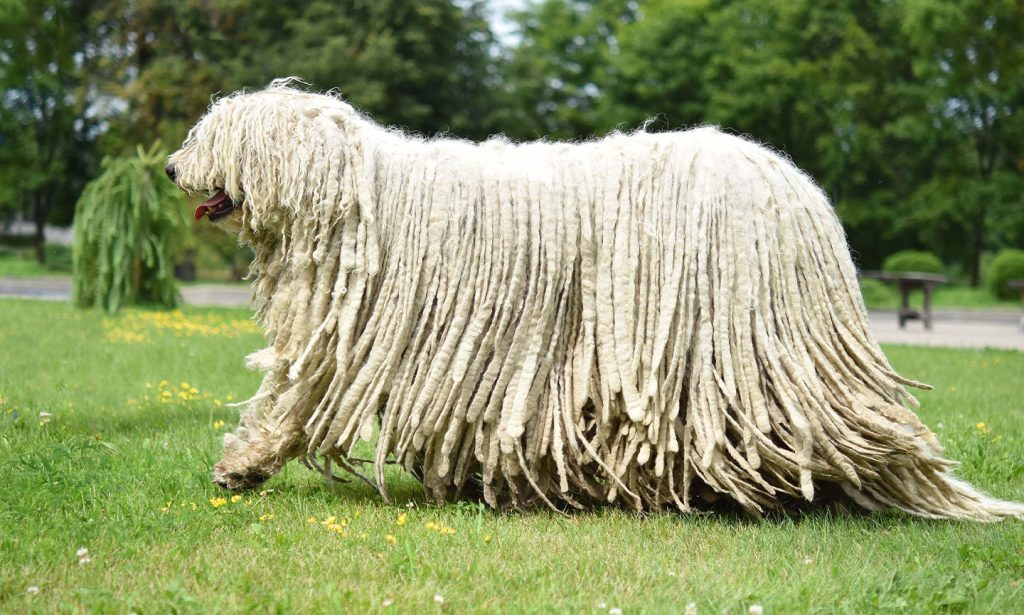
Size and Breed Category
The Komondor is a large breed of dog that originated in Hungary. They are classified as a working breed and are known for their protective instincts. The average height of a male Komondor is 27 inches (68 cm) and the average weight is 110 pounds (50 kg). Females are slightly smaller, with an average height of 25 inches (64 cm) and an average weight of 88 pounds (40 kg).
The Komondor has a distinctive appearance due to their long, corded coat. The coat is made up of thick, matted strands of hair that can grow up to 12 inches (30 cm) in length. The coat serves as protection from the elements and predators, as well as giving the dog a unique appearance. The breed is known for being independent and strong-willed, making them a good choice for experienced dog owners. They require regular grooming to maintain their coat, as well as plenty of exercise to keep them healthy and happy.
Fur Length and Colour
The fur of the Komondor is one of its most distinctive features. It is long and thick, forming cords that hang down from the body. The cords can grow up to 30 cm in length and are usually white or cream in colour. The fur is also quite dense, providing excellent insulation against cold weather. The cords are formed by the fur twisting and matting together, which can take up to two years to fully develop. The fur is also hypoallergenic, making it a good choice for people with allergies.
The colour of the Komondor’s fur can vary slightly, with some individuals having a slightly yellow or beige tint to their cords. However, the majority of Komondors have a pure white or cream-coloured coat. The fur is also quite coarse to the touch, which helps to protect the dog from the elements. The cords can also be quite heavy, weighing up to 15 kg in total. Despite this, the fur requires relatively little maintenance, with the cords only needing to be separated occasionally to prevent matting.
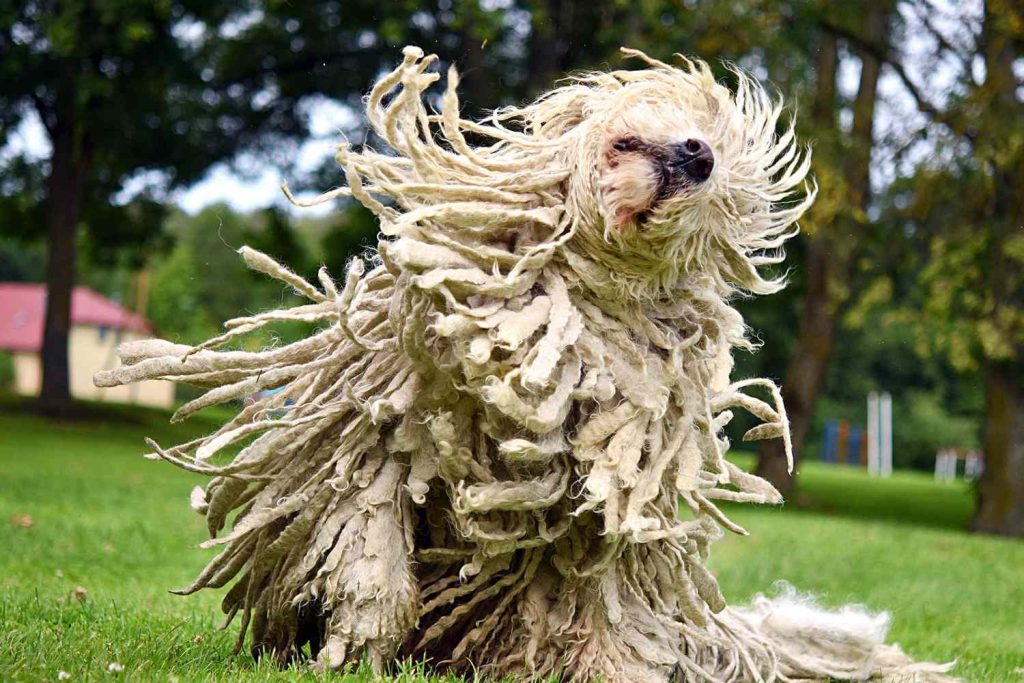
Termperament and Trainability
The Komondor is a breed of dog that is known for its independent and protective nature. They are typically reserved with strangers and can be wary of new people and situations. However, with proper socialization and training, they can become loyal and affectionate companions.
In terms of trainability, the Komondor can be a challenge for inexperienced owners. They are intelligent dogs, but their independent nature can make them stubborn and difficult to train. They require a firm and consistent approach to training, and positive reinforcement methods are recommended. With patience and dedication, the Komondor can learn a variety of commands and tasks, but they may never be as obedient as some other breeds.
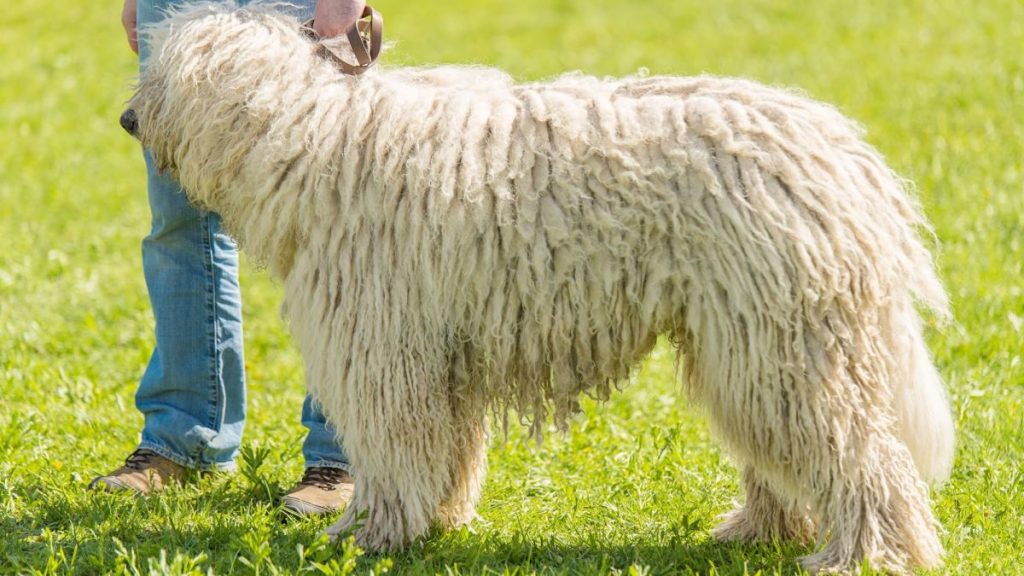
Known Health Conditions
Komondors are a breed of dog that are known to be prone to certain health conditions. One of the most common health issues that affect Komondors is hip dysplasia. This is a condition where the hip joint does not develop properly, leading to pain and discomfort for the dog. It can also cause arthritis and mobility issues. To prevent hip dysplasia, it is important to ensure that Komondors are not over-exercised when they are young, and that they are fed a balanced diet to maintain a healthy weight. Regular check-ups with a veterinarian can also help to detect any signs of hip dysplasia early on.
Another health condition that can affect Komondors is bloat, also known as gastric torsion. This is a serious condition where the stomach fills with gas and twists, cutting off blood supply to the organs. Bloat can be life-threatening and requires immediate veterinary attention. To prevent bloat, it is important to feed Komondors smaller, more frequent meals throughout the day, rather than one large meal. It is also important to avoid exercise immediately after eating, and to ensure that the dog has access to plenty of fresh water at all times.

Openness to Strangers
Komondors, also known as Hungarian sheepdogs, have a reputation for being fiercely protective of their families. However, this does not mean that they are not open to strangers. In fact, Komondors can be quite friendly and welcoming to new people, as long as they are introduced properly. They are intelligent dogs that can quickly learn to distinguish between friend and foe, and will only become aggressive if they perceive a threat to their family or territory. Overall, Komondors are loyal and devoted companions that will go to great lengths to protect their loved ones.
Despite their protective nature, Komondors can be quite sociable and enjoy meeting new people. They are not typically aggressive towards strangers, and will often greet them with a wagging tail and a friendly demeanor. However, it is important to note that Komondors are independent dogs that can be stubborn at times. They require a firm and consistent hand in training, and may not always obey commands from strangers. Nevertheless, with proper socialization and training, Komondors can be excellent family pets that are both protective and welcoming to visitors.
Playfulness Level
The Komondor is a highly playful breed of dog that loves to engage in various activities. They are known for their energetic and lively nature, which makes them a great companion for families with children. These dogs are always up for a game of fetch or a run around the park, and they have a natural instinct to play and have fun. Their playful nature also makes them great at learning new tricks and commands, as they are always eager to please their owners. Overall, the Komondor is a fun-loving and playful breed that brings joy and excitement to any household.
Despite their large size, the Komondor is a surprisingly agile and active breed of dog. They love to run, jump, and play, and they have a natural curiosity that drives them to explore their surroundings. This breed is also known for their love of water, and they enjoy swimming and playing in lakes and rivers. Their playful nature makes them a great choice for families who enjoy spending time outdoors, as they are always up for an adventure. Whether it’s playing in the backyard or going on a hike, the Komondor is a fun-loving and energetic breed that is sure to bring a smile to your face.
Suitability as a Pet for Children
Komondors have a unique appearance due to their long, corded coat. They are a highly intelligent breed that is known for their loyalty and protective nature. They require a lot of exercise and mental stimulation to keep them happy and healthy. Due to their size and strength, they may not be suitable for families with very young children. However, with proper training and socialization, they can make great pets for older children who are able to handle their size and energy.
Exercise Needs
Komondors require a significant amount of exercise to maintain their physical and mental health. As a large breed, they need plenty of space to run and play, making them better suited to homes with large yards or access to open spaces. A daily walk of at least an hour is recommended, but they will benefit from additional exercise such as running, hiking, or swimming. It is important to note that Komondors have a strong instinct to protect their family and territory, so they should always be kept on a leash or in a secure area when exercising in public.
In addition to physical exercise, Komondors also require mental stimulation to prevent boredom and destructive behavior. They are intelligent dogs that thrive on learning new tasks and being challenged. Training sessions that incorporate obedience, agility, or tracking are great ways to provide mental stimulation while also strengthening the bond between the dog and owner. Puzzle toys and interactive games can also be used to keep their minds engaged. It is important to provide a variety of activities to prevent boredom and keep the Komondor mentally and physically healthy.
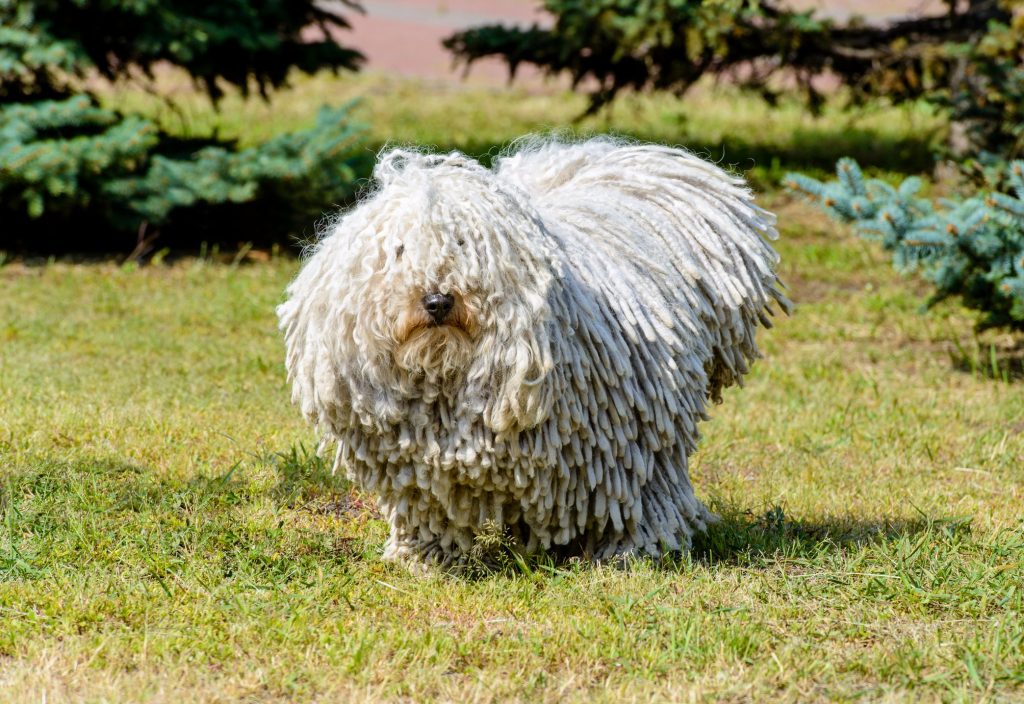
Suitability for a Multi-Pet Family
Komondors have a reputation for being fiercely protective of their family and territory. They were originally bred to guard livestock, so they have a strong instinct to protect. This can sometimes lead to aggression towards other animals, especially if they perceive them as a threat. However, with proper socialization and training, Komondors can learn to coexist peacefully with other pets. It’s important to introduce them to other animals at a young age and supervise their interactions to ensure everyone stays safe.
Housing Requirements
Komondors require a spacious living environment that can accommodate their large size and active nature. They need a minimum of 30 square meters of indoor space and access to a secure outdoor area for exercise and play. The outdoor area should be at least 100 square meters and have a high fence to prevent them from escaping. Komondors are known for their protective nature, so it is important to ensure that the outdoor area is secure and free from potential threats.
In addition to a spacious living environment, Komondors require a comfortable sleeping area that is warm and dry. They have a thick, corded coat that provides insulation, but they still need a warm and comfortable place to rest. A large, comfortable bed or mat is ideal, and it should be placed in a quiet area of the house where they can rest undisturbed. Komondors are loyal and affectionate dogs that thrive on human companionship, so it is important to provide them with plenty of attention and affection to keep them happy and healthy.
Summary
The Komondor has a strong and independent personality, making them a better fit for experienced dog owners who can provide them with the necessary training and socialization. They require a lot of exercise and space to roam, so they may not be suitable for those living in small apartments or without access to a yard. Additionally, their thick coat requires regular grooming and maintenance. Overall, the Komondor may be a good pet for the right owner who can meet their unique needs.
Komondor Dog FAQS
No, Komondors can be stubborn and independent, making them difficult to train. No, Komondors are not recommended for apartment living due to their size and exercise needs. They require a large yard or open space to roam. Yes, Komondors are excellent guard dogs due to their protective nature and loyalty. Yes, Komondors are known to be good with children, but they require socialization and training. Yes, Komondors are prone to hip dysplasia and bloat. Regular vet check-ups are recommended. Yes, Komondors need daily exercise, such as long walks or runs. No, Komondors do not shed a lot, but their cords require regular maintenance. Komondors require regular grooming, including brushing and bathing every 2-3 months. A Komondor can grow up to 80 cm tall. The average weight of a Komondor is between 36-60 kg.
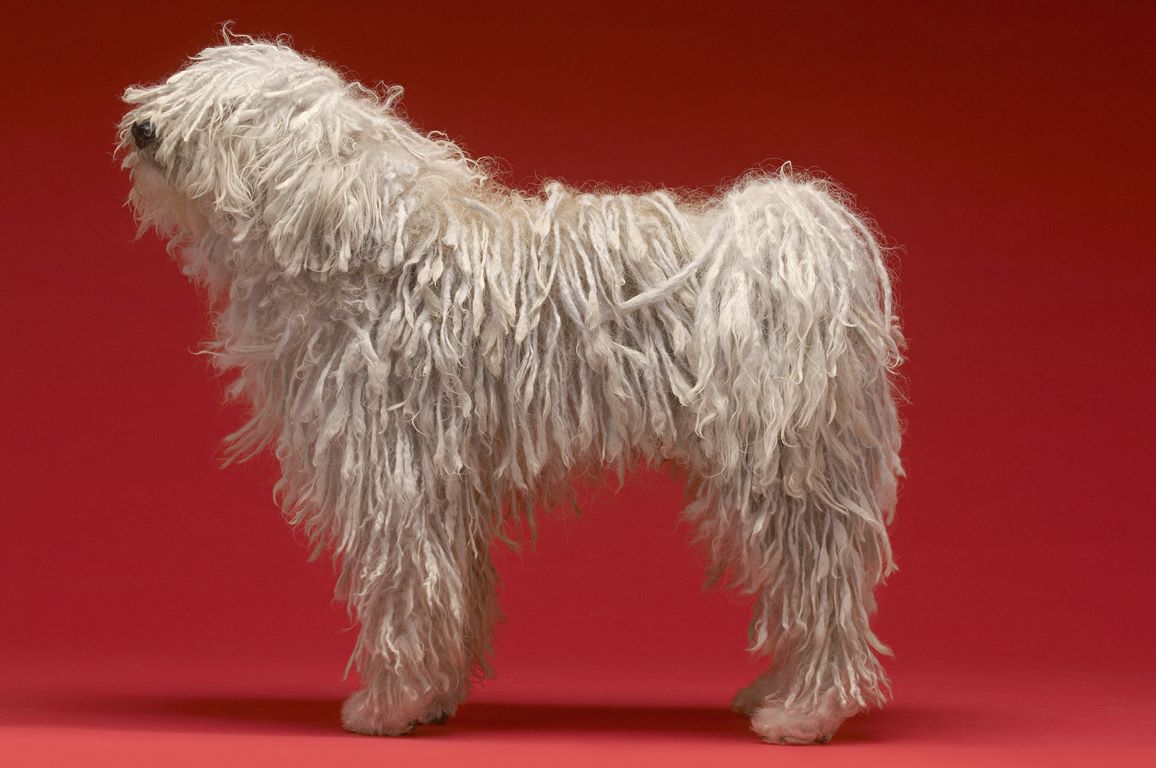
Leave A Comment